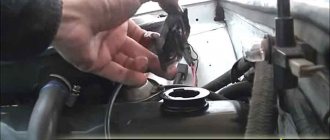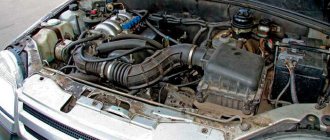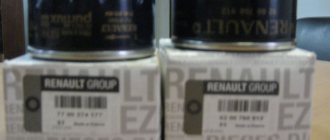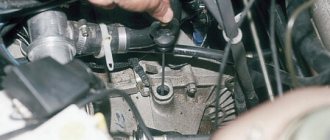How much oil should be poured into the engine? Instructions for selecting and changing oil
As soon as people buy a car, they do not immediately think about the future costs of car care. The first questions of car owners usually concern the lubricant: how much should be poured into the engine, how to check its level, how to replace it, and so on.
General characteristics of engine oil
Car oil can be mineral, synthetic or semi-synthetic. Mineral oil is a natural product obtained by refining petroleum products. Synthetics, as the name suggests, are artificial in nature and are created as a result of chemical synthesis, while semi-synthetics are obtained when mineral and synthetic oil enters the engine.
Which option is the best?
Synthetics retain their beneficial properties the longest. However, many motorists prefer semi-synthetic types and consider it the best. The viscosity parameter is very important for oil. This reduces the friction of engine components against each other, thereby maintaining their properties. Additives are the third most important parameter of oil performance. They perform a cleaning function, remove resin deposits, improve grinding mechanisms during startup, and reduce friction between components.
The best oil in winter
During the cold season, some car owners use the same type as at other times of the year; this is an all-season material. But some, on the advice of experts, switch to special motor oil.
Which is better for cold weather? Depending on the oil change season, it is necessary to take into account not only its quality characteristics, which certainly play a certain role, but also the feasibility of this action. After all, if the car is in a warm garage, it is unlikely that the engine will need any other fluid. For new cars, of course, you cannot skimp on oil. By using the best brands of fluids, car owners will increase the service life of their unit.
How to choose oil for your car
If you want to make the right choice, you must first find your car's owner's manual. After studying it, you will find what properties the oil should meet. However, you can decide for yourself which brand to buy. But it happens that some brands are not suitable for a particular car. Therefore, it is worth paying attention to this attention.
How much oil should be poured into the engine
To answer this question, first read your vehicle's owner's manual. This figure depends on the volume of the car. For example, for an engine with a volume of 1.8 liters to two and a half, the oil should be 3.7 liters. But in practice this is not always the case. The reason is that when the oil is completely changed, it will not flow out completely, but some will remain in the engine.
How to check the oil level
To get the correct number, you need to know how to check engine oil correctly:
- the machine must stand on a level surface;
— the machine should stand turned off for three to fifteen minutes, then the oil will have time to flow into the pan;
Pull out the dipstick, wipe it with a rag, then put it in and pull it out again and check. On some foreign cars you can just look at the dashboard
Source
How is the fluid changed?
If you are faced with this task for the first time, here are some tips:
Engine oil drain
- Place the machine on a level surface. The ideal option is a garage pit or overpass.
- Before draining the fluid, drive the car around the city or on the highway for 30-40 minutes so that operating temperature is established inside the engine system.
- Change the oil filter every time you change the oil lubricant.
- Removing old oil is done by unscrewing the oil filler neck at the top of the engine and pulling out the drain plug under the car. The crankcase protection must be removed before replacement.
- It is not recommended to use devices for “express replacement” too often: they do not draw out the entire amount of lubricant, leaving part of the working fluid at the bottom of the unit. As a result, obsolete and new fluids are mixed, which leads to a decrease in engine life.
How and how much oil should be added to the engine?
By listing the functional tasks of oil, we will try to determine its actual role in the fate of transport. It always supports:
- Keep engine parts clean;
- Lightweight and excellent pumping in case of cold engine start;
- Heat removal from heated engine parts; reliability of its operation at high temperatures in the area of the cylinder-piston group;
- Reliable lubrication of power unit parts;
- Ensuring the neutralization of corrosive agents accumulated during engine operation.
To give the necessary performance characteristics or improve existing ones, functional additives are used, which are added directly to the oil.
- 1 Main reasons for consumption
- 2 Key oil indicators
- 3 How to change engine oil 3.1 What needs to be done
Too high oil level: good or bad?
An option is being considered when the lubricant level in the internal combustion engine is higher than on the dipstick. The reason is an overflow of oils associated with the inattention of the car owner or insufficient warming up of the engine before replacement. Some drivers believe that the higher the oil level in a car engine, the better the engine will pull, but this is not true.
An increased level of lubrication can cause great harm to the car, because the oil pressure in the engine increases, which will lead to damage to the unit. Gaskets and seals may be damaged. Therefore, if the engine oil level is too high, do not use the vehicle.
Main reasons for consumption
The oil consumption indicator is largely responsible for the technical condition of the engine. As a rule, many professional drivers take this issue very seriously when buying a used car. But not everyone knows that increased oil consumption does not always indicate an engine malfunction, while the absence of oil consumption does not guarantee the absence of these malfunctions.
Oil consumption for each car is individual and depends on engine size. For example, for V6 or V8 units 1 liter per 1000 km is the norm, but for small cars this is a lot. The oil in the engine cylinders burns and, remaining on its walls, it covers the internal surfaces with a film in order to prevent dry friction. And in the chamber combustion of the film with the fuel mixture occurs. Diagnosing the main causes of high oil consumption in most cases turns out to be quite a difficult task.
Tips on oil types
Remember that an excessive amount of lubricating fluid in the power unit has a negative effect and creates excessive pressure, which is extremely bad for the engine. In the future, this can lead to failure of the crankshaft liners.
Be sure to read what type of oil you need to fill: synthetic, semi-synthetic, mineral.
Manufacturers of lubricating fluids do not recommend mixing one type with another, since the chemical composition is different and the oil may coagulate and jam the components inside, which means major repairs. Related article:
Is it possible to pour synthetics after semi-synthetics?
There are cases when the crankshaft rod can pierce the aluminum wall of the cylinder head. In exceptional cases, you can mix different types of oils to get to the service station. After which it is necessary to thoroughly rinse the engine, change the oil filter and fill in new oil of the same type. The distance for such an emergency situation is no more than 50-60 km, at a speed of 60 km/h.
The concept of “the engine eats oil”:
No matter what the engine is, new or after a major overhaul, it will still eat oil in small quantities. This is how physics dictates. It’s just that everyone’s volumes are different. So, small cars from V to 1500 cc. cm consume 250 - 300 grams per 1000 km. mileage, cars with large V up to 400 g/1000 km. from the point of view of the laws of physics, oil burning in the cylinder leaves behind a film on the walls, thereby preventing excessive wear and reducing the friction force of parts against each other.
Key oil indicators
The indicator that is a characteristic of the oil is called viscosity, which depends on the air temperature - in the case of a cold start in the winter and up to the maximum temperature load in the summer. Every car driver should understand what kind of oil to pour into the engine. But, at the same time, it is worth understanding that the product itself is not always to blame for the appearance of defects. For example, synthetic oils have high fluidity, which means it is easier for it to seep through loose oil seal connections. This defect does not indicate its aggressiveness, but indicates wear on the working edge of the cuff, through which any oil can leak. For engines of outdated design, the use of synthetics is not provided.
- For a new engine, it is recommended to use a product of SAE 5W30 or 10W30 classes all year round;
- For a technically sound engine - in the summer season SAE 10W40, 15W40 in the winter 5W30 and 10W30, and in any season SAE 5W40;
- For an old engine - in summer SAE 15W40 and 20W40, in winter SAE 5W40 and SAE 10W40, for any season SAE 5W40.
Other causes of lubricant leakage
In addition to those that occur most often and are described above, there may be other reasons when, knowing how much oil needs to be poured into the engine normally and having provided it, you have to add it more and more:
- the intake manifold control system is broken;
- the engine fluid level sensor has lost its seal;
- the filter element is not sealed;
- too much oil is poured in, which causes its operating pressure to increase - because of this, the load on the rings and oil seal increases, which can also become unusable;
- non-use of transport for a long period of time, when due to inactivity the sealing elements with seals may dry out;
- poor level of ventilation - if gases collect in the crankcase, the pressure in the system will be critical and will begin to squeeze out consumables.
So, now it is clear how much oil is needed in the engine when replacing and topping up during normal operation. If more is required during operation, this indicates emerging problems that are best solved without waiting for more global ones to appear.
The amount of oil in the engine differs depending on the make of the car. According to the standard, domestic cars are characterized by a lower capacity than foreign cars. Oil should be poured into the engine correctly, taking into account the characteristics of the vehicle. Otherwise, there is a possibility that all components of the car under the hood will flood.
The amount of oil in the engine differs depending on the make of the car.
How to change engine oil
This function is necessary to extend the life of car engine components. The more timely the replacement is carried out, the longer the service life of the power unit will be. Every car owner can perform this procedure independently. To do this, it is enough to have several skills.
Before starting work, it is recommended to read the instructions and prepare the required amount of engine oil with the required markings (in the operating manual) with consumables. To be sure of the quality of the product, it is best to buy it in specialized stores that can provide a documentary guarantee of quality. Also, do not forget about buying an oil filter.
To avoid problems during work, it is recommended to drive the car either into an inspection hole or onto an overpass. You will need a special container into which the waste will need to be drained.
What need to do
First of all, you need to secure the car to prevent it from moving. To do this, the car must be put on the handbrake, and the plane itself on which the car will be installed must be level.
The engine must be warmed up to operating temperature.
- Shut off the unit and open the filler neck into which the flushing liquid should be poured;
- Close the neck and start the engine, leaving it running until the “oil pressure” light comes on;
- Stop the engine and drain the oil from the pan;
- Unscrew the oil filter and fill it with new product;
- Screw the plug on the pan and install the oil filter in place;
- Fill the engine with oil to the level indicated on the dipstick.
After carrying out the work, you need to start the engine at low speeds and check for possible leaks.
The oil level is checked when the car is installed on a strictly horizontal surface. This is done to obtain the correct level indicator. If the product level is below the required level, it must be topped up.
How to add oil
You need to turn off the engine and leave the car on a flat horizontal area for several hours: for example, from evening to morning. During this time, the maximum volume of lubricating fluid will drain into the pan. After this, pull out the dipstick and look at the level. This needs to be done in two steps: first, take out the control rod and wipe it with a rag. Then lower it into the pan again and pull it out again: then the readings will be as accurate as possible. Further:
- add 100-200 ml of oil;
- wait at least 10-15 minutes for the engine fluid to drain into the pan;
- check the level by pulling out the dipstick;
- repeat the procedure if necessary.
Required amount of engine oil
Also, many car owners are interested in the question of how much oil should be poured into the engine. The answer to this question cannot be unambiguous, since each car model needs its own amount of product.
For domestically produced cars, you need to fill in about four liters of oil. According to the advice of experts, three liters are immediately poured in, after which the level is checked using a dipstick, which is located next to the engine and which on the outside resembles a plastic handle. And if necessary, top up the product.
In foreign cars with an engine capacity of 2.0 - 2.4 liters, it is also recommended to fill no more than four liters and then use a dipstick to check the level of the product, which should also be added if necessary. Motors with larger displacement require more product.
It is recommended to check the level at least once a week. This will save you on expensive repairs. It is checked before starting the engine. Under no circumstances should you check the level of the product or pour oil into the engine while it is running, otherwise this may lead to injury - either a jet of boiling oil hitting your face, or the level reading will not correspond to reality. If, when replacing it, a few drops get on the engine, it is recommended to carefully wipe them off with a napkin.
When asked what kind of oil to pour into the engine, I would like to give a definite answer that the correct selection of the type and brand of oil is the key to the smooth operation of the engine. In order not to disrupt the proper operation of the engine, it is necessary to take into account what kind of oil was poured previously. That is, if it was “semi-synthetic”, then such a product should be filled in, if it was “synthetic”, then that’s it. If there is no way to find out what kind of oil was used previously (this situation may arise when buying a used car), it is recommended to flush the engine before pouring a new one.
Reasons for excessive oil consumption
Among car owners, the question is often asked: how much oil do you need to top up between changes? There is no clear answer to this question. The service instructions for some cars contain information that the so-called. oil consumption “for waste” is acceptable, indicating the quantity.
Practice shows that a serviceable engine consumes an amount that does not exceed the amount of oil left when changing (provided that you knew how much to pour and bought the exact amount).
When draining the waste, about 10% of the amount remains, which is exactly how much oil will remain in the container. And if the motor is worn out, excess consumption occurs for the following reasons:
- oil scraper rings are stuck or require replacement due to wear;
- valve seals (valve seals) have become stiff or worn out;
- the tightness of the cylinder head gasket is broken, lubricant gets into the coolant;
- There are leaks through the pan gasket or oil seals.
Oil change frequency
According to experts, it is better to change the oil more often. But on the other hand, according to many car owners, the cost of good oil is quite expensive, and also replacing it requires time, which is often not enough.
Filling the engine with oil
But it is worth understanding that the era of the so-called eternal cars has long sunk into oblivion. Even today, there are 30-year-old and even older cars on the roads. It is ridiculous to assume that “cars” produced in the 2000s will last for such a long time. It’s all very simple - today’s car manufacturer is not at all interested in the issue of the length of the vehicle’s operational life. It needs to maintain the service infrastructure, which means that car owners’ cars simply must break down, and new ones must leave car dealerships accordingly. So, calculating the engine oil change interval and how much oil to pour into the engine does not in any way bother the manufacturer. His only concern concerns the operation of the engine during service. So if there is still someone who believes in the fairy tale about a conscientious car manufacturer, it is recommended to take off your rose-colored glasses and plunge into reality.
What type of motor oil to choose
A few words about what you can pour into the engine crankcase of your “iron horse”.
Modern engines are characterized by high power density (horsepower per kilogram of mass). The working process conditions are quite harsh, so it is necessary to ensure work with a supply of lubricant to the mating area of the parts.
With “dry” friction, parts quickly fail. When working with an oil film, the service life of parts increases tens of thousands of times. Therefore, the purpose of motor oil is to be where it is needed constantly. Engine oil consumption must be commensurate with its operation.
How much oil should be poured into the engine
It is impossible to give a definite answer to this question. Vehicles of different manufacturers and brands have their own lubrication system design. In addition to the crankcase, the oil fluid is located in the pipeline, filter, crankshaft, and other components. How many liters of oil you need to pour into your own engine can be found in the operating manual. This is true when you need to fill the lubricant for the first time. The manufacturer indicates the proper filling rate if the power unit is hollow, just assembled.
After draining the oil solution from the system, some of it remains not drained. This is 300-500 grams of lubricant. It is possible to determine how many liters of oil to pour into a car engine by following the recommendations developed for this. Engines of domestic cars with a volume of 1.8 to 2.4 liters can contain from 3.5 to 4.0 liters of oil fluid. The same imported power units will contain from 4.0 to 4.3 liters of lubricant. To determine how much oil is in the engine, you need to use a dipstick and perform several steps:
- You must initially pour 3.5-3.8 liters of lubricant into the filler neck.
- Wait 2-3 minutes and check the level of the lubricant solution with a dipstick.
- If the value is insufficient, then you need to add 100-200 grams and check the degree of filling again.
The procedure must be repeated until the desired filling level is achieved. When pouring lubricant, you must remember that it is better to add little by little than to immediately overflow. Pumping back the lubricant from the system is a very problematic task. If too much lubricant enters, it will flood the engine parts and components near it. This will lead to foaming of the oil and heavy operation of the power unit. If the filling indicator is less than normal, the rubbing components and parts will quickly wear out.
The required lubricant filling rate can be presented in a cheat sheet.
| Volume of the power plant, l | Engine oil volume, l | |
| Domestic units | Foreign units | |
| 1.6 | 3.3-4.0 | 3.5-4.2 |
| 1.8 | 3.6-4.1 | 3.8-4.3 |
| 2.0 | 3.9-4.4 | 4.0-4.5 |
| 2.2 | 4.0-5.5 | 4.2-5.6 |
| 2.5 | 4.0-5.7 | 4.2-5.8 |
| 3.0 | 4.5-7.5 | 4.6-7.7 |
| 4.0 | 7.0-8.5 | 7.2-8.7 |
| 4.4 | 7.5-9.5 | 7.7-9.7 |
| 5.5 | 8.0-10.0 | 8.2-10.2 |
Startup problems
If the volume is significantly less than the recommended amount, it will take longer to reach top engine speed after the ignition is turned on. Ideally, it should reach these components in just a couple of seconds.
It is extremely important to regularly monitor the engine oil level. This is due to its possible consumption both due to wear of the cylinder-piston group, and during break-in or due to gasket or filter leakage. If the level drops below o, then you need to top up at least to the middle of the dipstick. As for overflow, it is not so terrible, although it is harmful. The excess will burn off and the level will adjust over time.
If you notice that the consumption is too high (more than 1.5 liters per 1,000 km), then you need to take action. Increased oil consumption may be due to too high engine speeds or wear of the cylinder-piston group and increased clearances in the combustion chamber. Because of this, oil will get there and burn along with the fuel-air mixture.
It is possible to determine how much oil to pour into the engine of a particular car experimentally. For example, you buy a 4- or 5-liter canister and a filter and start replacing it. Although it is much easier to open the service book and find out the exact volume, brand and viscosity of engine oil. The advice of an experienced motorist who has already done this work on his car several times can also help. In general, this is all that can be said about the amount of oil poured into the engine. It all depends on the type of engine and its size. For 1.6 you need approximately 3.5 liters. For 2.0 and 2.4 - about 4-5 liters.
Recommend: Diesel Engine High Pressure Fuel Pump
There are many motorists in Russia who are accustomed to relying solely on themselves when servicing their cars. This not only guarantees financial benefits (no need to spend money on the services of third-party specialists), but also ensures the proper quality of work.
One of the most popular ways for valiant servicemen to “con” car enthusiasts is still poor-quality replacement of engine oil: for some they don’t change it at all, for others they forget to change the filter, and for others they charge money for the additional volume of fluid that settles in the bins of the cunning master. Meanwhile, even a housewife can perform such a simple operation. To do this you need to have a couple of keys and really love your car. However, if you decide to perform this procedure yourself, it would be useful to find out how much oil you need to purchase for your engine. Today we are talking about four ways to determine how many liters need to be poured into the engine.
Can't you spoil the porridge with oil?
First of all, remember that the saying “you can’t spoil porridge with oil” does not work at all in the case of an internal combustion engine. Each individual motor is designed to work with a certain volume of lubricant. Of course, manufacturers provide a certain delta - maximum and minimum levels. These are the parameters that should be followed. If the engine oil level is too low, the engine will wear out much faster and cool poorly, and excessive volume will quickly damage the crankshaft seals and cause severe contamination of the intake tract. This is the same case when overfilling is just as dangerous as underfilling. Therefore, the volume to be filled must be approached responsibly.
To find out how much oil you need to purchase and pour into your engine, you can use any search engine on the Internet. However, the information obtained in this way may be incorrect and based only on speculation. In order not to make mistakes in such an important matter, we recommend using simple recommendations.
Methods for determining oil volume
1.
The easiest and most correct way is to find the owner's manual that came with your car from the factory. As a rule, every modern car has several Talmuds that tell about all the features of this model. Look in the contents and find the item “Vehicle Specifications”. In this section you will find the sub-heading “Lubrication System”. That's where the treasured numbers are located. For example, it will be said that the total volume of oil to be filled is 4.2 liters if the filter is replaced and 3.9 if it is not changed. You will also find information about what kind of oil needs to be filled - its type and viscosity.
Manufacturers usually recommend using oils produced under their own or a friendly brand. In fact, you can use absolutely any oil with similar parameters from any manufacturer - nothing bad will happen to the engine. It is only important that the specification of the lubricant meets the parameters specified by the motor manufacturer (the corresponding tolerances are directly on the canister label). Depending on the manufacturer, the sections of the instructions may vary, but the information you need is definitely there, you just need to take the time to find it.
2.
If for some reason the instructions have not been saved, you can use the official website of your car manufacturer. Often you can download the entire owner's manual or find basic information about the characteristics of your motor. Its specifications are easy to determine; just look at the registration certificate.
3.
Well, if you don’t find the information you need even there, use the help of specialized sites for selecting oil. By entering the make and model, year of manufacture into the appropriate fields and selecting the engine, you will receive many options for oils from different manufacturers. At the same time, you will be offered a package that will have enough oil to spare.
The Renault K7M 1.6 8V engine is used for installation in Renault Logan 1.6 8V, Renault Sandero 1.6 8V, Renault Clio 1.6 8V, Renault Symbol. Peculiarities.
The Renault K7M 1.6 engine is structurally no different from the one, the only difference is the volume increased to 1.6 liters. The increase in volume was achieved by increasing the radius of the crankshaft crank (other dimensions are the same); as a result, the piston stroke increased from 70 mm to 80.5 mm. The height of the cylinder block has increased, but all its geometric parameters are identical to the K7J. The Renault K7M and K7J engines have the same cylinder head and connecting rods. Engine life is 400 thousand km. Based on the K7M engine, a motor with a 16-valve cylinder head was created. This engine has more advanced characteristics and technologies.
We recommend: Fishing from a boat: what do you need for this?
Determine oil level - methods
To find out the amount of oil in a car engine, several requirements must be met. They are mandatory:
- the car must be placed on a level surface;
- the power unit must be cool. If the check is carried out after stopping the vehicle, then you must wait 15-20 minutes. During this time, the temperature of the starting unit will decrease, the pressure in the lubrication system will drop, and the oil solution will drain into the crankcase;
- The lubricant level must be measured using a standard dipstick.
There are marks on the surface of the probe: min and max. They indicate the minimum and maximum permissible filling volume of oil in a car engine. The process of determining the lubricant level consists of the following points:
- The dipstick must be removed from its regular place and the remaining lubricant must be wiped off with a clean rag.
- Install the measuring rod in its original place.
- Remove the gauge again and inspect the oil layer. It should be located between the min and max marks.
- If the lubricant layer is below the minimum mark, then an oil solution must be added to the lubrication system.
- If the lubricant level is above the maximum mark, excess lubricant must be drained from the system.
Nowadays, almost all cars are equipped with computer warning systems for the presence of oil solution and its consumption. It is not recommended to completely trust computer data. Sometimes, especially before and after a long trip, you need to check the lubricant level in the power plant yourself.
Recommendations for draining: how, when and how much
Oil must be poured into the engine correctly. Here are some recommendations.
- Testing is carried out with a warm engine, especially if the replacement is carried out in the cold season. This is necessary because hot oil is not so viscous and thick. Therefore, it will flow out of the crankcase more easily.
- It is necessary to unscrew the filler plug on the valve cover. Then vacuum inside the motor can be avoided, and the waste fluid will flow out faster.
- There is no need to rush. It should take at least half an hour.
- When adding fresh oil, the level on the dipstick serves as a guide. First, seventy percent is filled, the engine is started for a couple of minutes, turned off, and after ten minutes it is gradually topped up. The level of how much oil is in the engine is checked a few minutes after topping up so that all the lubricating fluid has time to reach the crankcase.
- If the motor is no longer new, then it is necessary to maintain a quantity that is close to the maximum and check it often. Otherwise, the risk of oil starvation increases. And in the case of an old engine, this can have very sad consequences.
Intervals when you need to replace
The service book for the vehicle specifies the mileage after which the lubricant solution must be replaced. In the absence of intense operating conditions, driving on the highway outside the city, the mileage between lubricant changes can be up to 15,000 km. Operating vehicles in city traffic will reduce mileage to 9000-11000 km. But these data are not completely accurate, since the condition of the lubricant is influenced by several factors, which include:
- Type and quality condition of the fuel being filled.
- Power plant volume.
- The type of lubricant that was previously filled and its condition.
- The number of hours worked by the engine.
- Technical condition of the vehicle.
- Vehicle operating conditions and power plant operating modes.
These factors can change the quality of the lubricant. Loss of its characteristics by the lubricant will lead to rapid wear of the power plant. In such a situation, an analysis of the oil solution carried out in laboratory conditions can give an accurate answer about the quality of the lubricant and the need to replace it.
The need for replacement according to engine hours
The initial data is the stable average speed of the vehicle in the city and the manufacturer's recommendations for changing the lubricant. Let's say the speed in the city is 40 km/h, and the factory recommendations for replacement are 15,000 km.
To calculate engine hours, you need to divide the distance by the speed limit. In this situation, 15000/40=375 m/h. The obtained value means that after 375 operating hours of the power plant it is necessary to change the oil.
The API international standard has developed a summary table for replacing oils, depending on their type and service life.
| Type of oil solution | Operating hours |
| Mineral | 130-150 |
| SyntheticARI SJ/SHAPI SL/SMPolyalphaolefinsEsters | 230-250320-350370-400430-450 |
| Semi-synthetic | 230-250 |
Let’s assume that an SL/SM oil solution with a working life of 330 hours was poured into the vehicle engine. To determine mileage, you need to multiply 330 m/h by the average traffic of 40 km/h. As a result, the mileage until the next lubricant change will be 13,200 km.
Need for replacement due to fuel consumption
The initial data should be fuel consumption per 100 km of movement according to passport data and actual. For example, according to the passport, consumption is 9 liters per 100 km, but the actual consumption is 11 liters. According to the passport, the oil change should be carried out every 15,000 km of vehicle movement.
Fuel consumption is calculated using the proportional method for passport and actual data separately. For passport data: 15000x9/100=1350 liters. For actual data: 15000x11/100=1650 liters.
The actual distance through which new oil must be filled is calculated by a similar proportion: 1350x15000/1650= 12270 km.
Each method can be used for any vehicle. It is only necessary to record the data at the moment of pouring lubricant into the motor.
Let's sum it up
In order to determine how much oil to pour into a car engine, you must follow several recommendations:
- Choose a car oil for the vehicle that will be constant throughout its operation. The lubricant must be selected taking into account the operating conditions of the vehicle.
- If the vehicle is actively used, check the oil fill level using a dipstick at least once every 3-4 days.
- Monitor the interval between runs when replacing the lubricant.
- Fill the engine with lubricant in accordance with technology. Do not underfill or overfill the solution.
- If you lack experience, knowledge or doubt, contact a service station that has the necessary equipment. Specialists will carry out the necessary work on the engine, regardless of whether it is diesel or gasoline.
Compliance with the recommendations guarantees long-term operation of the power unit.
Source
What car enthusiasts say about how much engine oil is needed to change
- How much engine oil is needed to change if the car is not used much?
“When the car is started no more than once a week, the lubricant level should be checked regularly and replaced if necessary. Moreover, this should be done more often than the automaker indicates. The reason is that condensation forms inside the internal combustion engine. If you rarely drive your car, condensation will begin to mix with the combustion products of the fuel mixture. Condensation is acid and will corrode the engine.” - When should you change the lubricant?
“Of course, if your budget is unlimited, please change the lubricant and filter element at least monthly. But maintenance rules weren’t just invented. Otherwise, dealerships would have closed long ago if car owners came to change their engine oil under warranty so often.” - How much engine oil does it take to change?
“You need exactly as much lubrication as indicated in the instruction manual. The window will show o and “max” - these are the limits of the permissible level. Of course, you can fill in more than 5 liters, but as soon as you start the engine, the lubricant will begin to squeeze out, and the internal combustion engine will fail.” - Which filter element should I use and how much lubricant will I need to replace?
“I have a Passat. How much engine oil do I fill? 3.9 l if the filter element is large, or 3.5 l when the filter is small. There are motors on which a large filter element is immediately installed during production.” - How much lube should be ideal?
“The owner's manual indicates how much engine oil is needed for a change: 4.4 liters. However, I do not recommend filling more than 4 liters. After all, it will not be possible to completely remove the old grease. If you add 4 liters of fresh lubricant, the engine oil level will be higher than the middle between o and “max”.











